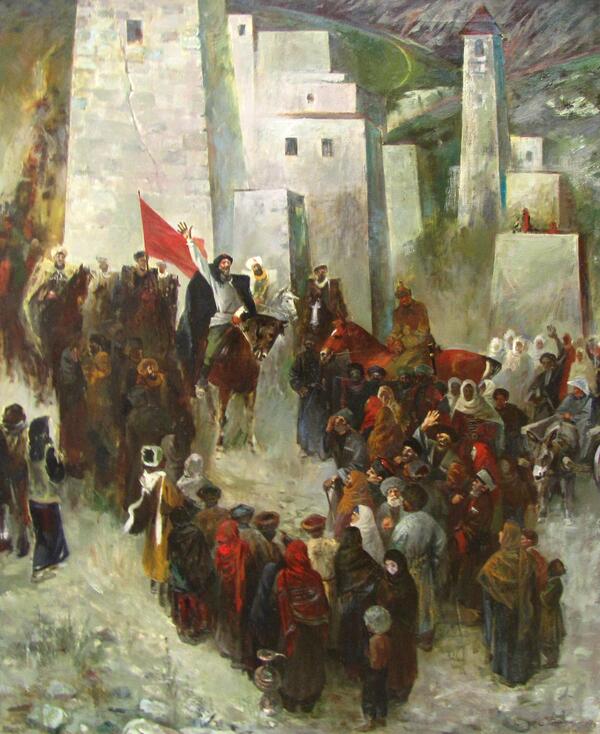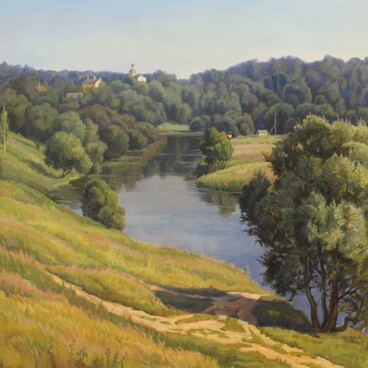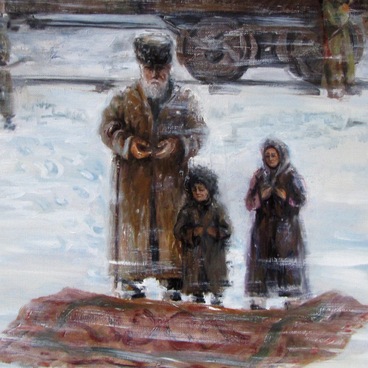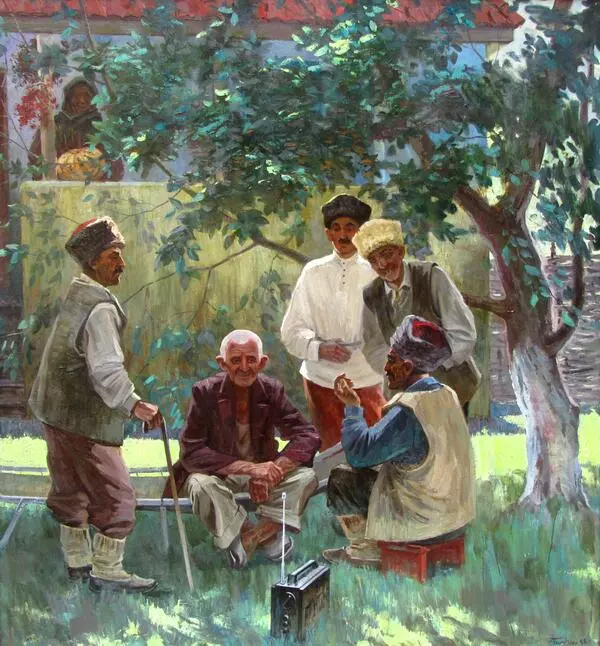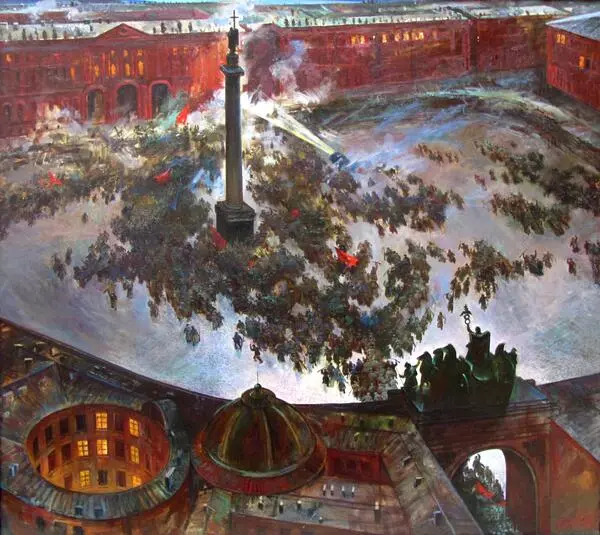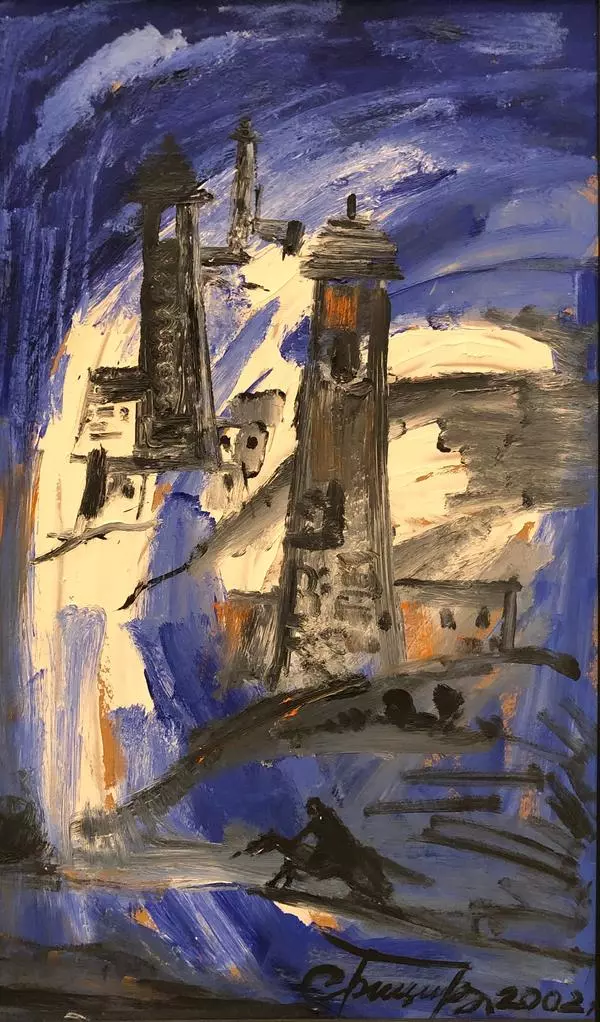The painting by Said Bitsiraev “Appeal” is dedicated to the events of the Civil War in Russia (1918–1922). Its central part depicts the inhabitants of the mountain aul (villages in the Caucasus and Central Asia) against the background of fortress towers: they gathered in the main square of the village to meet with the Red Army. All people are dressed in national costumes: men’s clothes consist of cherkeskas, tight trousers that are tucked into boots, and high hats. Women wear loose-fitting dresses, their heads are covered with large scarves.
Slightly to the left of the center of the canvas, the artist painted an equestrian Red Army soldier in a burka (felt cloak). He raised his right hand as if appealing to the audience to do something. A red banner flutters behind him — a symbol of revolution and communism. There are mountain peaks in the background, behind the towers.
Said, or Saithussein, Bitsiraev was born on January 30, 1954, in the Kyrgyz village of Kadomzhai: his parents were sent there after being deported from their native Chechen Republic. At the age of 15, Bitsiraev entered the Krasnodar Art College, graduated in 1973, and two years later continued his studies at the Ilya Repin Institute of Painting, Sculpture and Architecture at the USSR Academy of Arts. There, the aspiring artist studied in the workshop of the famous Soviet painter and graphic artist Yuri Neprintsev.
Childhood became one of the most important themes in Said Bitsiraev’s works. He painted pictures where children played in village streets and jumped in puddles after the rain based on his own memories.
It was the Spanish poet Federico García Lorca who inspired Bitsiraev to create one of his most famous cycles. The artist visited Spain twice, painted landscapes from nature and from memory, and then named them using lines from Lorca’s poems. In total, the series includes more than 30 works. In 2004, the art historian and art critic Abram Raskin published the book “The Spanish Rhapsody of Said Bitsiraev”, which describes this cycle in detail.
Bitsiraev dedicated a number of his works to China and Greece cultures. He also painted portraits of his contemporaries, as well as historical canvases related to the events of different eras in his native republic.
Slightly to the left of the center of the canvas, the artist painted an equestrian Red Army soldier in a burka (felt cloak). He raised his right hand as if appealing to the audience to do something. A red banner flutters behind him — a symbol of revolution and communism. There are mountain peaks in the background, behind the towers.
Said, or Saithussein, Bitsiraev was born on January 30, 1954, in the Kyrgyz village of Kadomzhai: his parents were sent there after being deported from their native Chechen Republic. At the age of 15, Bitsiraev entered the Krasnodar Art College, graduated in 1973, and two years later continued his studies at the Ilya Repin Institute of Painting, Sculpture and Architecture at the USSR Academy of Arts. There, the aspiring artist studied in the workshop of the famous Soviet painter and graphic artist Yuri Neprintsev.
Childhood became one of the most important themes in Said Bitsiraev’s works. He painted pictures where children played in village streets and jumped in puddles after the rain based on his own memories.
It was the Spanish poet Federico García Lorca who inspired Bitsiraev to create one of his most famous cycles. The artist visited Spain twice, painted landscapes from nature and from memory, and then named them using lines from Lorca’s poems. In total, the series includes more than 30 works. In 2004, the art historian and art critic Abram Raskin published the book “The Spanish Rhapsody of Said Bitsiraev”, which describes this cycle in detail.
Bitsiraev dedicated a number of his works to China and Greece cultures. He also painted portraits of his contemporaries, as well as historical canvases related to the events of different eras in his native republic.

